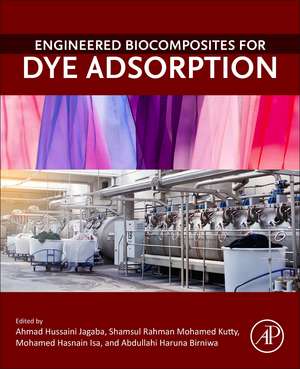Engineered Biocomposites for Dye Adsorption
Editat de Ahmad Hussaini Jagaba, Shamsul Rahman Mohamed Kutty, Mohamed Hasnain Isa, Abdullahi Haruna Birniwaen Limba Engleză Paperback – 22 ian 2025
The book shows how combining materials such as biocomposites significantly yields better dye adsorption than a single material and addresses conventional issues with adsorption such as adsorbent cost, effectiveness, regeneration, and sustainability and provides insights into the preparation and use of new adsorbent materials for dye removal from aqueous solutions. The information contained in this book will increase readers’ fundamental knowledge, guide future researchers, and can be incorporated into future works on experimental studies on dye adsorption. As such it serves as an indispensable resource and reference work for engineers, wastewater specialists, biotechnologists, chemists, microbiologists, researchers, and students studying industrial effluents, biomass, bioproducts, and adsorption processes.
- Offers a collection of the state-of-the-art dye removal methods using conventional and advanced/new adsorbents
- Provides a detailed understanding of the methods of preparation and properties of new adsorbents and biocomposites
- Includes applications of biocomposite adsorbents in dye removal, their effectiveness and limitations, and process optimization
Preț: 1096.73 lei
Preț vechi: 1429.90 lei
-23% Nou
Puncte Express: 1645
Preț estimativ în valută:
209.85€ • 219.13$ • 173.29£
209.85€ • 219.13$ • 173.29£
Carte tipărită la comandă
Livrare economică 08-22 aprilie
Preluare comenzi: 021 569.72.76
Specificații
ISBN-13: 9780443298776
ISBN-10: 0443298777
Pagini: 472
Dimensiuni: 216 x 276 mm
Greutate: 1.28 kg
Editura: ELSEVIER SCIENCE
ISBN-10: 0443298777
Pagini: 472
Dimensiuni: 216 x 276 mm
Greutate: 1.28 kg
Editura: ELSEVIER SCIENCE
Cuprins
1. Industrial dye effluent sources, generation, characteristics, and value-added products
2. Impacts of dye contaminated effluents on the environment
3. Fundamental and mechanisms of adsorption processes for dye removal
4. Theoretical and mechanisms of adsorption processes for dye removal by composite adsorbents
5. Activated carbon and its derivative biocomposites for dye adsorption
6. Biochar, hydrochar and their derivative biocomposites for dye adsorption
7. Waste Industrial Sludge and its Derivative Biocomposites for Dye Adsorption, A Comprehensive Review
8. Agricultural wastes and their derivative biocomposites for dye adsorption
9. Geological materials and their derivative biocomposites for dye adsorption
10. Recent Advances in the Preparation and Modification of Eco-friendly Zeolite-based Biocomposites for Dye Adsorption
11. Graphene and its derivative biocomposites for dye adsorption
12. Carbon nanotubes and their derivative biocomposites for dye adsorption
13. Zero-valent iron and its derivative biocomposites for dye adsorption
14. Polymers and their derivative biocomposites for dye adsorption
15. Advances and Prospects of Polymeric Nano-Biocomposites for Dye Adsorption
16. Biopolymer-Based Hydrogels and their Composites for Enhanced Adsorptive Removal of Dyes: Recent Perspectives
17. Metals and their derivative biocomposites for dye adsorption
18. Metal nanoparticles and their derivative biocomposites for dye adsorption
19. Nanomaterials and their derivative biocomposites for dye adsorption
20. Recent Advances in Application of Metal Organic Frameworks for Adsorption of Dye from Wastewater
21. Advances in COFs and COF-Based Biocomposites in Dye Adsorption Processes and Applications
22. Techno-economic and life-cycle assessment of biocomposites for dye adsorption
23. Cleaner and circular bioeconomy approaches for the application of biocomposites in simultaneous dye adsorption and resource recovery
24. Innovations in Sustainable Wastewater Treatment: Integrating Engineered Biocomposites for Enhanced Dye Adsorption
25. Adsorption of Dyes onto 2D Materials and Bio-composites; Environmental Applications and Challenges
26. Performance of Unactivated and Activated Coffee Husk Biochar under Room Temperature Using HNO3 and NaHCO3 for Indigo Carmine dye Adsorption from Water
2. Impacts of dye contaminated effluents on the environment
3. Fundamental and mechanisms of adsorption processes for dye removal
4. Theoretical and mechanisms of adsorption processes for dye removal by composite adsorbents
5. Activated carbon and its derivative biocomposites for dye adsorption
6. Biochar, hydrochar and their derivative biocomposites for dye adsorption
7. Waste Industrial Sludge and its Derivative Biocomposites for Dye Adsorption, A Comprehensive Review
8. Agricultural wastes and their derivative biocomposites for dye adsorption
9. Geological materials and their derivative biocomposites for dye adsorption
10. Recent Advances in the Preparation and Modification of Eco-friendly Zeolite-based Biocomposites for Dye Adsorption
11. Graphene and its derivative biocomposites for dye adsorption
12. Carbon nanotubes and their derivative biocomposites for dye adsorption
13. Zero-valent iron and its derivative biocomposites for dye adsorption
14. Polymers and their derivative biocomposites for dye adsorption
15. Advances and Prospects of Polymeric Nano-Biocomposites for Dye Adsorption
16. Biopolymer-Based Hydrogels and their Composites for Enhanced Adsorptive Removal of Dyes: Recent Perspectives
17. Metals and their derivative biocomposites for dye adsorption
18. Metal nanoparticles and their derivative biocomposites for dye adsorption
19. Nanomaterials and their derivative biocomposites for dye adsorption
20. Recent Advances in Application of Metal Organic Frameworks for Adsorption of Dye from Wastewater
21. Advances in COFs and COF-Based Biocomposites in Dye Adsorption Processes and Applications
22. Techno-economic and life-cycle assessment of biocomposites for dye adsorption
23. Cleaner and circular bioeconomy approaches for the application of biocomposites in simultaneous dye adsorption and resource recovery
24. Innovations in Sustainable Wastewater Treatment: Integrating Engineered Biocomposites for Enhanced Dye Adsorption
25. Adsorption of Dyes onto 2D Materials and Bio-composites; Environmental Applications and Challenges
26. Performance of Unactivated and Activated Coffee Husk Biochar under Room Temperature Using HNO3 and NaHCO3 for Indigo Carmine dye Adsorption from Water
